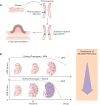Molecular pathways and therapies in autosomal-dominant polycystic kidney disease
- PMID: 25933820
- PMCID: PMC4422974
- DOI: 10.1152/physiol.00032.2014
Molecular pathways and therapies in autosomal-dominant polycystic kidney disease
Abstract
Autosomal-dominant polycystic kidney disease (ADPKD) is the most prevalent inherited renal disease, characterized by multiple cysts that can eventually lead to kidney failure. Studies investigating the role of primary cilia and polycystins have significantly advanced our understanding of the pathogenesis of PKD. This review will present clinical and basic aspects of ADPKD, review current concepts of PKD pathogenesis, evaluate potential therapeutic targets, and highlight challenges for future clinical studies.
©2015 Int. Union Physiol. Sci./Am. Physiol. Soc.
Conflict of interest statement
No conflicts of interest, financial or otherwise, are declared by the author(s).
Figures


Comment in
-
Understanding renal physiology leads to therapeutic advances in renal disease.Physiology (Bethesda). 2015 May;30(3):171-2. doi: 10.1152/physiol.00005.2015. Physiology (Bethesda). 2015. PMID: 25933816 Free PMC article. No abstract available.
References
-
- Arnould T, Kim E, Tsiokas L, Jochimsen F, Grüning W, Chang JD, Walz G. The polycystic kidney disease 1 gene product mediates protein kinase C alpha-dependent and c-Jun N-terminal kinase-dependent activation of the transcription factor AP-1. J Biol Chem 273: 6013–6018, 1998. - PubMed
-
- Beck Gooz M, Maldonado EN, Dang Y, Amria MY, Higashiyama S, Abboud HE, Lemasters JJ, Bell PD. ADAM17 promotes proliferation of collecting duct kidney epithelial cells through ERK activation and increased glycolysis in polycystic kidney disease. Am J Physiol Renal Physiol 307: F551–F559, 2014. - PMC - PubMed
-
- Bell PD, Fitzgibbon W, Sas K, Stenbit AE, Amria M, Houston A, Reichert R, Gilley S, Siegal GP, Bissler J, Bilgen M, Chou PC, Guay-Woodford L, Yoder B, Haycraft CJ, Siroky B. Loss of primary cilia upregulates renal hypertrophic signaling and promotes cystogenesis. J Am Soc Nephrol 22: 839–848, 2011. - PMC - PubMed
Publication types
MeSH terms
Substances
Grants and funding
LinkOut - more resources
Full Text Sources
Other Literature Sources

